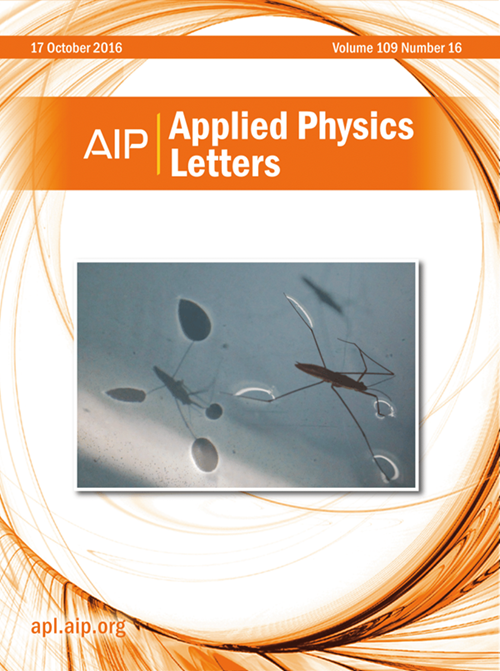用于无标记液晶-水界面全细胞胃肠道病原体痢疾志贺氏菌光学检测的高选择性适体传感器
IF 3.5
2区 物理与天体物理
Q2 PHYSICS, APPLIED
引用次数: 0
摘要
本文描述了一种基于无标记液晶(LC)的生物传感器,该传感器使用细菌特异性适配体在水界面上快速直接地检测整个细胞痢疾志贺氏菌。lc的刺激接受特性导致lc -水界面分子取向顺序的改变。这种界面现象已被用来记录生物传感器的靶结合相互作用。利用对准剂二甲基十八烷基[3-(三甲氧基硅基)丙基]氯化铵和阳离子表面活性剂十六烷基三甲基溴化铵的自组装性能,分别获得了玻璃- LC和水- LC界面上的同向取向。带负电荷的志贺氏适体的引入使各向同性分子变为平面/倾斜有序。在液体培养基中加入少量志贺氏菌细胞后,适体-细菌相互作用导致lc -水界面表面活性剂的重新分布,恢复了同向取向。这导致在偏光显微镜下观察到从亮到暗的光学变化,从而暗示微生物的存在。该报告的适体传感器具有高特异性,在1-105 CFU/ml的线性范围内,检测限为30 CFU/ml。为了测试该系统的实用性,还对该传感器进行了近分类学亲缘菌痢疾杆菌以及来自食物链的真实样本的测试。与传统的检测技术相比,这种基于lc的传感器具有许多优点,可以快速方便地检测整个细胞目标。本文章由计算机程序翻译,如有差异,请以英文原文为准。
Highly selective aptasensor for optical detection of whole cell gastrointestinal pathogen Shigella dysenteriae at label-free liquid crystal–aqueous interface
This paper describes a label-free liquid crystal (LC)-based biosensor for a rapid and straightforward detection of whole cell Shigella dysenteriae at aqueous interfaces using a bacteria-specific aptamer. The stimuli-receptive properties of LCs induce a change in the orientational ordering of molecules at the LC–aqueous interface. This interfacial phenomenon has been utilized to record target binding interactions of the biosensor. The homeotropic LC alignment at the glass–LC and the aqueous–LC interfaces was obtained using the aligning agent dimethyloctadecyl [3-(trimethoxysilyl)propyl] ammonium chloride and the self-assembling property of the cationic surfactant cetyltrimethylammonium bromide, respectively. The introduction of the negatively charged Shigella aptamer causes the homeotropic molecules to morph to a planar/tilted ordering. Upon adding a small quantity of Shigella cells in liquid media, the aptamer–bacterium interaction causes a redistribution of the surfactant at the LC–aqueous interface, restoring the homeotropic alignment. This results in a bright-to-dark optical change observed under a polarizing optical microscope, thus implying the presence of the microbes. This reported aptasensor demonstrates high specificity, with the limit of detection being 30 CFU/ml within a linear range of 1–105 CFU/ml. To test the utility of this system, the sensor was also tested with close taxonomic relatives S. dysenteriae as well as real samples from the food chain. This proposed LC-based sensor offers several advantages over conventional detection techniques for a quick and convenient way for the detection of whole cell targets.
求助全文
通过发布文献求助,成功后即可免费获取论文全文。
去求助
来源期刊

Applied Physics Letters
物理-物理:应用
CiteScore
6.40
自引率
10.00%
发文量
1821
审稿时长
1.6 months
期刊介绍:
Applied Physics Letters (APL) features concise, up-to-date reports on significant new findings in applied physics. Emphasizing rapid dissemination of key data and new physical insights, APL offers prompt publication of new experimental and theoretical papers reporting applications of physics phenomena to all branches of science, engineering, and modern technology.
In addition to regular articles, the journal also publishes invited Fast Track, Perspectives, and in-depth Editorials which report on cutting-edge areas in applied physics.
APL Perspectives are forward-looking invited letters which highlight recent developments or discoveries. Emphasis is placed on very recent developments, potentially disruptive technologies, open questions and possible solutions. They also include a mini-roadmap detailing where the community should direct efforts in order for the phenomena to be viable for application and the challenges associated with meeting that performance threshold. Perspectives are characterized by personal viewpoints and opinions of recognized experts in the field.
Fast Track articles are invited original research articles that report results that are particularly novel and important or provide a significant advancement in an emerging field. Because of the urgency and scientific importance of the work, the peer review process is accelerated. If, during the review process, it becomes apparent that the paper does not meet the Fast Track criterion, it is returned to a normal track.
 求助内容:
求助内容: 应助结果提醒方式:
应助结果提醒方式:


